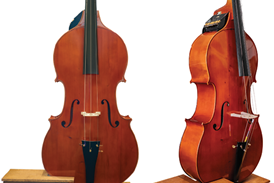New research into violin wood density suggests that it is
unlikely that classical Cremonese makers had access to wood with
significantly different material properties than that available to
contemporaneous or modern makers.
In a study published online in the peer-reviewed, open access
journal Plos One, Terry Borman, Berend Stoel and Ronald de Jongh
used computed tomography (CT) densitometry to analyse 17 classical
and modern Dutch, German, Austrian and French violins. They then
compared the results with results from a 2008 study in which Borman
and Stoel analysed the wood density of 13 modern and Cremonese
violins.
The instruments in the new study included violins by Hendrik
Jacobs, Pieter Rombouts, Willem van der Syde, Jacques Boquay and
Jacob Stainer.
The researchers found only small differences in the densities of
the maple and spruce used by violin makers from several countries
and over a time frame of more than 300 years. They concluded: 'Our
results indicate increasing difficulty in sustaining the notion
that the classical Cremonese violin makers such as Stradivari and
Guarneri 'del Gesù' had access to wood with significantly different
material properties than what contemporaneous could, or modern
makers can, access.'
To read the full paper, click
here.
- News
- For Subscribers
- Student Hub
- Playing Hub
- Directory
- Lutherie
- Magazine
- Magazine archive
- Whether you're a player, maker, teacher or enthusiast, you'll find ideas and inspiration from leading artists, teachers and luthiers in our archive which features every issue published since January 2010 - available exclusively to subscribers. View the archive.
- Jobs
- Shop
- Podcast
- Contact us
- Subscribe
- School Subscription
- Competitions
- Reviews
- Debate
- Artists
- Accessories






































No comments yet